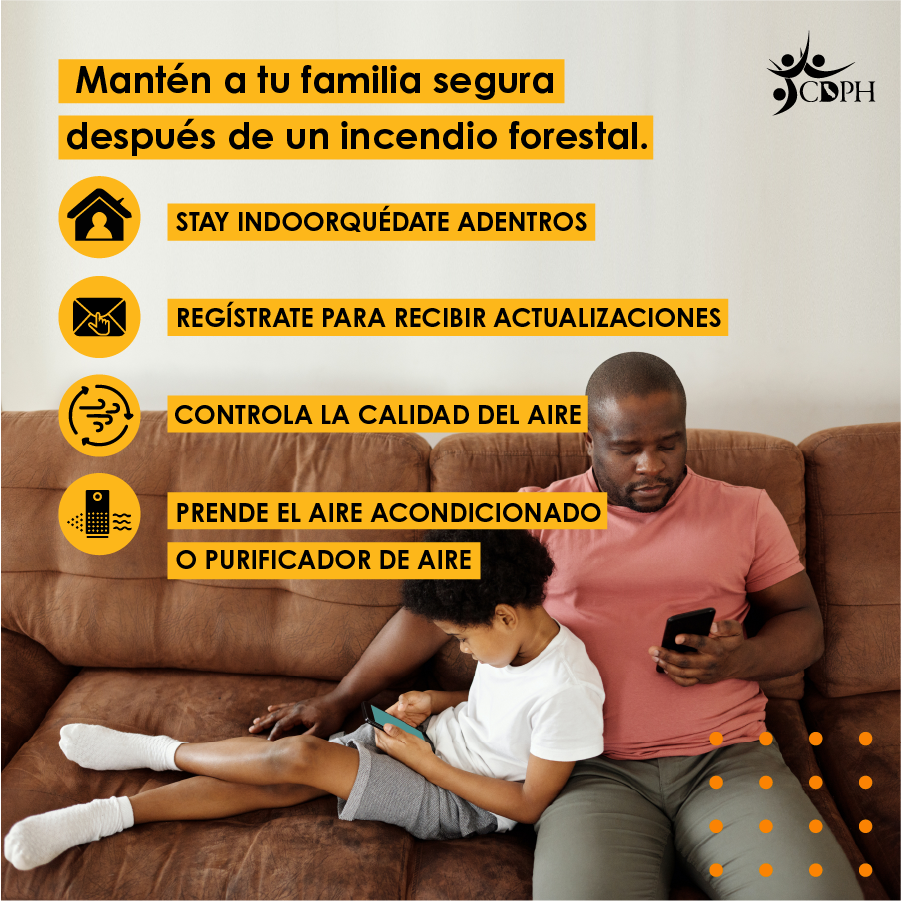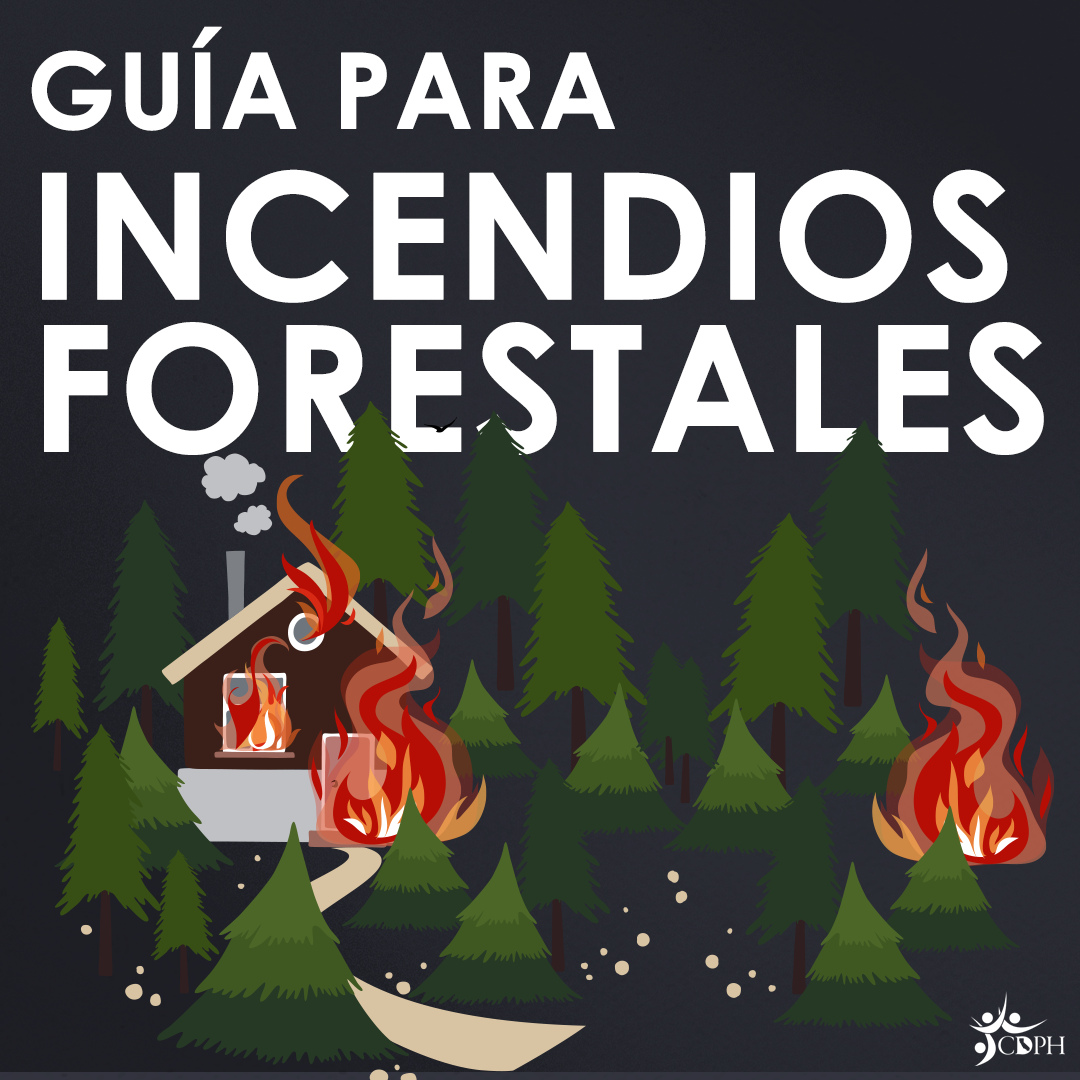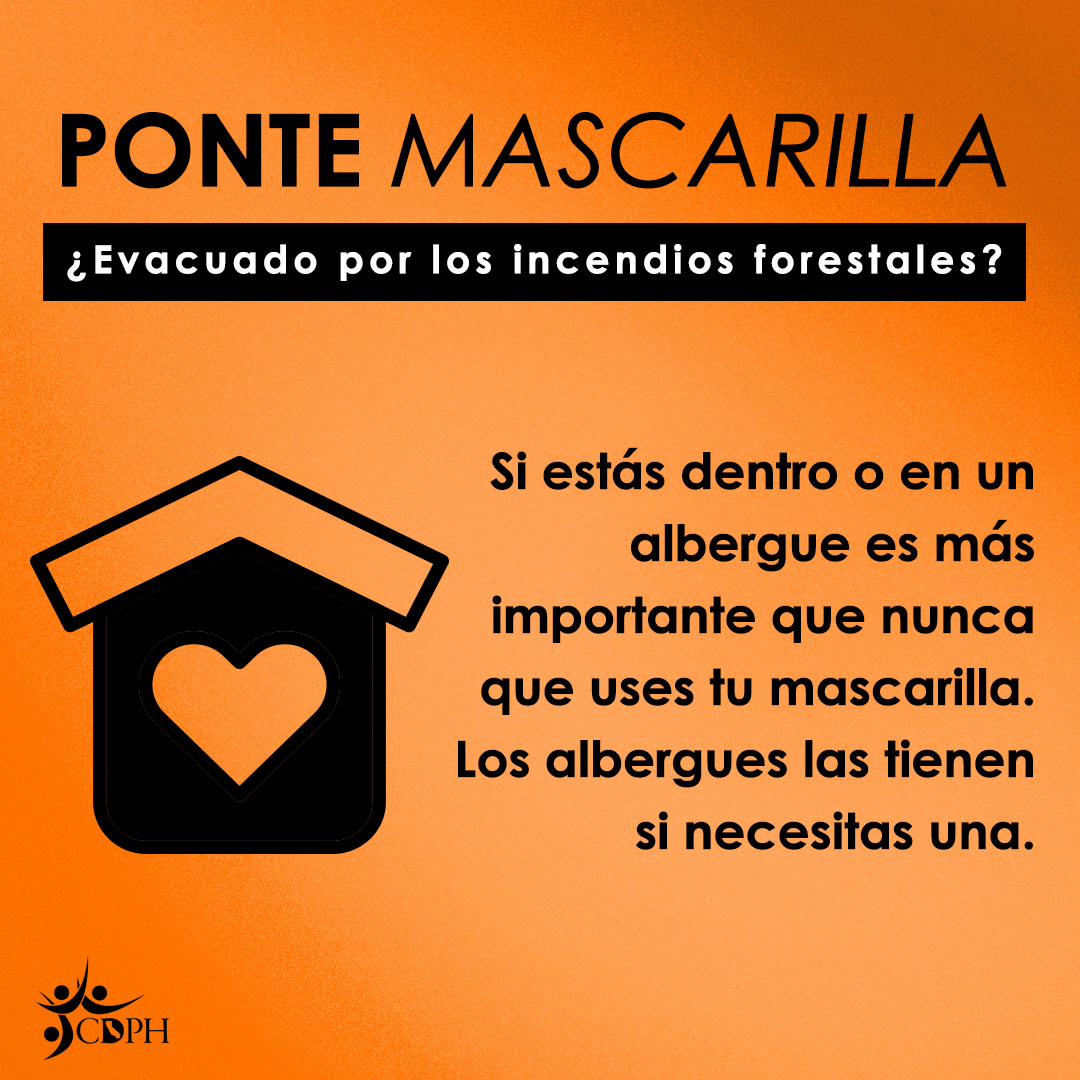 Suggested Messaging:
Los incendios forestales pueden dejar cenizas en el aire, lo que puede causar tos persistente, secreción nasal, flema, respiración silbante y dificultad para respirar. Toma medidas para reducir los contaminantes del aire en tu hogar durante los incendios forestales. - Cambia la configuración de tu unidad de aire acondicionado para recircular o cierra la ventilación exterior
- Verifica la calidad del aire y evita salir al aire libre cuando hay mala calidad del aire
- Cierra todas las ventanas, puertas y rejillas de ventilación fuera de la casa: también puedes colocar toallas húmedas cubriendo la parte inferior de las puertas y las ventanas como precaución adicional.
- Usa una mascarilla N95 cuando salgas al aire libre
Obtén más información sobre cómo protegerte del humo y las cenizas durante los incendios forestales en: https://www.cdph.ca.gov/Programs/EPO/Pages/Wildfire%20Pages/Smoke-Ash-Safety.aspx
|
 Suggested Messaging:
Los niños y las mascotas pueden ser más susceptibles a problemas de salud por inhalar cenizas. Asegúrate de:
- No permitir que los niños o las mascotas entren en áreas que puedan contener cenizas calientes, árboles carbonizados, escombros ardientes.
- Estar atento a los signos de problemas respiratorios durante y después de jugar al aire libre
- Limpiar todos los juguetes y áreas de juego
Obtén más información sobre cómo protegerte del humo y las cenizas durante los incendios forestales en: https://www.cdph.ca.gov/Programs/EPO/Pages/Wildfire%20Pages/Smoke-Ash-Safety.aspx
|

Suggested Messaging:
Si estás cerca de un incendio forestal, la mejor manera de evitar la inhalación de humo es permanecer en interiores. Si tienes que salir al aire libre en condiciones de humo durante períodos de tiempo largo, debes usar una mascarilla N95. Para más información sobre mascarillas N95 visita: https://bit.ly/cdphwildfires |

Suggested Messaging: Las mascarillas de respiración N95 pueden filtrar partículas de menos de 0.3 micrómetros. En comparación, el ancho de un solo cabello humano es aproximadamente 60 micrómetros. Para obtener más información sobre las mascarillas N95 visita: https://bit.ly/cdphwildfires
|

Suggested Messaging: Existen algunas limitaciones para las mascarillas N95. Es importante saber lo siguiente: - No se ajustan a los niños y no se pueden adaptar para que se ajusten adecuadamente a un niño.
- La barba completa o en crecimiento y el bigote largo pueden impedir que las mascarillas N95 sellen correctamente.
Para más información sobre las mascarillas N95 visita: https://bit.ly/cdphwildfires
|

Suggested Messaging: Las mascarillas N95 no son difíciles de poner, pero es importante asegurarte de que la mascarilla esté bien sellada contra tu cara. Para más información sobre las mascarillas N95 visita: https://bit.ly/cdphwildfires |

Suggested Messaging: Hay varias marcas y modelos diferentes de mascarillas N95, por lo que es importante realizar una "prueba de ajuste" antes de que surja una emergencia. Para más información sobre las mascarillas N95 visita: https://bit.ly/cdphwildfires |

Suggested Messaging: Al guardar las mascarillas N95, debes protegerlas de daños, contaminación, luz del sol, temperaturas extremas y productos químicos dañinos. Las condiciones del almacenamiento también pueden afectar su vida útil, para más información: https://bit.ly/cdphwildfires |

Suggested Messaging: Durante un incendio forestal, la primera prioridad es protegerte a ti y proteger a tus seres queridos. Si te ordenan evacuar tu casa o el área, hazlo inmediatamente. Todo lo demás es secundario. Obtén más información en https://bit.ly/cdphwildfires |

Suggested Messaging: Cuando un incendio forestal amenaza tu área, sigue estas indicaciones: - Pon atención a las estaciones de la radio o televisión local para obtener la información más reciente sobre incendios forestales.
- Prepárate para evacuar en cualquier momento. • Asegúrate de tener un kit de emergencia completo con medicinas, copias de recetas y suministros médicos.
- Ubica refugios cercanos, incluyendo los que aceptan mascotas. Asegúrate de traer los medicinas de tu mascota.
- Haz arreglos para quedarte con familiares o amigos fuera del área amenazada. Obtén más información en https://bit.ly/cdphwildfires
|

Suggested Messaging: irNow es una página web financiada por el gobierno federal que proporciona las condiciones actuales de incendios, avisos y pronósticos de humo, información sobre cómo los incendios pueden afectar tu salud y más. Para saber las condiciones actuales de la calidad del aire en tu área visita www.airnow.gov |

Suggested Messaging: La calidad del aire en tu área es segura? Lo único que necesitas es tu código postal para proteger tu salud y obtener las condiciones actuales de calidad del aire en www.airnow.gov |

Suggested Messaging: El humo de los incendios forestales puede causar irritación en los ojos y en el sistema respiratorio e incluso reacciones más graves. Si te encuentras en un área donde hay un incendio forestal, permanece en interiores y reduce las actividades al aire libre. Usa una mascarilla N95 si tienes que salir al aire libre. Para más información sobre cómo prepararte para los incendios forestales visita: https://bit.ly/cdphwildfires |

Suggested Messaging: Aquellos con enfermedades respiratorias, pulmonares o cardíacas deben limitar su exposición quedándose en interiores. El aire condicionado que recircula el aire interior, puede ser útiles para reducir la entrada de humo en tu hogar. Sigue las guías locales sobre la calidad del aire y los mensajes de salud y seguridad. Para más información: https://bit.ly/cdphwildfires |

Suggested Messaging: #EvacuandoporIncendios si estás en albergues debes usar mascarilla, tanto en interiores como al aire libre para protegerte del humo de los incendios forestales y de #COVID19. Los albergues tienen mascarillas N95 para aquellos afectados por los incendios. #INSERTFIRENAME (ex. #IncendioCaldor) Para más información: https://bit.ly/cdphwildfires |

Suggested Messaging: Protégete a ti y a tus seres queridos usando una mascarilla, tanto en interiores como fuera de los albergues para los evacuados por los incendios forestales. Las mascarillas N95 protegen de las partículas de humo de los incendios y todas las demás ayudan a detener la propagación de #COVID19. Los albergues te pueden dar una si la necesitas. #INSERTFIRENAME (ex. #IncendioCaldor) Para más información: https://bit.ly/cdphwildfires |
|